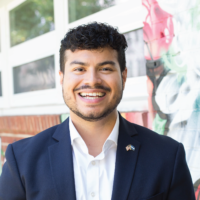March 6, 2024
How House and Senate Budget Proposals Would Impact Virginia Communities
When lawmakers make bold choices to raise resources, we can invest more in all of us. Last week, the House and Senate adopted budget amendments proposed by their respective money committees. These amendments rejected the worst of the governor’s proposed tax package and maintained a proposal to modernize the state sales tax base. While these proposals varied — the Senate proposes that businesses should not get special treatment related to the expanded sales tax base, while the House kept the proposal focused on transactions by everyday people — both would protect and raise significant resources for our communities. Compared to the governor’s introduced budget, the two chambers proposed significant funding for priorities in K-12 education, higher education, health care, and more. Read below to see how the House and Senate budget proposals compare.
Jump to:
Tax/Revenue
Back in December, the governor included a tax package in his budget proposal that would have overwhelmingly benefited the most wealthy, while asking those with the least to pay more. Overall this upside-down tax package would have cost nearly $1 billion in the upcoming two-year budget — funding that should go to priorities our communities want to invest in like public education, health care, direct support for families who need it most, and more. This package included:
- Reducing the individual income tax rates (costs $3.46 billion).
- Increasing the state sales tax on goods like shoes, clothes, and other essentials by 0.9 percentage points (raises $1.82 billion).
- Expanding the state sales tax base to “new economy” products like digital downloads and streaming services (raises $714 million).
- Increasing the non-refundable Earned Income Tax Credit (EITC) from 20 to 25% (costs $29 million).
- Doubling the dealer discount, which is the policy that allows retailers to retain a portion of their sales tax collections (costs $35.3 million).
- Increasing the annual cap on tax credits for people who donate toward scholarships at certain private schools and non-public prekindergarten programs (EISTC) from $25 million to $30 million (costs $10 million).
The combined impact of cutting the income tax bracket rates, increasing the sales tax rate, and increasing the state’s non-refundable EITC option would have resulted in, on average, low-income families in the bottom 20% of incomes (less than $30,000) facing a tax increase of $44, while households in the top 1% (more than $763,000) receiving an average cut of $9,640.
Both the House and the Senate rejected the worst of the governor’s proposed tax package. In addition, both chambers included proposals to expand and modernize the state sales tax base to “new economy” products, treating the sale of a digital download the same as a Blu-Ray disc when it comes to taxes, for example. Together, these changes will bring in significant resources over the governor’s proposed budget to invest in committee priorities.
- Both chambers struck language that would have split the portion of sales tax revenues dedicated to the Commonwealth Transportation Fund between the I-81 Corridor Improvement Fund and the Transportation Opportunity Fund.
- The House captured an additional $1.5 billion in resources by rejecting most of the governor’s tax package and expanding the sales tax base.
- The Senate also rejected most of the governor’s tax package and expanded the sales tax base. They also removed the business-to-business (B2B) transaction exclusion in the introduced budget, which gave businesses special treatment over everyday families. In total, the Senate added $2.3 billion in available resources to their proposal with these changes.
K-12 Education
The House and Senate budget amendments provide significant additional support to help Virginia students learn and thrive, including beginning to implement key near-term recommendations from JLARC (Virginia’s independent research agency) to improve Virginia’s school funding system. The House provides $940 million more for Virginia’s local school divisions than the governor’s proposal. The Senate — buoyed by additional revenue from extending the digital sales tax to business-to-business sales — invests $1.6 billion more than the governor. That’s money to lift the arbitrary cap on state funding for support staff, return Literary Fund money to be used for school construction, and, like the House, raise teacher pay, increase support for students from low-income families and English language learners, and increase funding for early childhood education.
- Improving support for students from low-income families and high-poverty schools (at-risk add-on): JLARC’s July 2023 report recommended (1) using the more up-to-date weighted Identified Student Percentage (ISP) data to calculate the add-on, (2) moving the add-on into the main school funding formula, and (3) shifting to having both a flat add-on and a variable concentration-of-poverty add-on. Both the House and Senate implement changes based on these recommendations and increase overall support for students from low-income families.
- The House provides an additional $385 million for Virginia’s at-risk add-on, which funds the state cost of moving from outdated free lunch data to the Identified Student Percentage (ISP) data with a 1.35 weight, adding a 6% “flat” add-on to basic aid per identified student, and moving the “concentration” weight to up to a maximum of 42.5% more for the school divisions with the highest concentration of low-income students. These changes provide $642 more per pupil on average for each year of the upcoming biennium in the highest-poverty school divisions.
- The Senate provides an additional $370 million GF and $25 million from the Lottery Fund for Virginia’s at-risk add-on, which funds the cost of a new “flat” add-on based on the average of the Identified Student Percentage and the free lunch rate, plus the number of students enrolled in the Virginia Preschool Initiative, plus the cost of moving the “concentration” weight up to a maximum of 45.2% more for the school divisions with the highest concentration of low-income students, using the existing free lunch data. These changes provide $376 more per pupil on average for each year of the upcoming biennium in the highest-poverty school divisions.
- Boosting teacher and staff pay: Virginia’s teachers were paid just 68 cents on average for every dollar paid to their peers with similar levels of education and experience in other fields in 2022, which is the third worst pay penalty in the country. The House and Senate both take steps in their budget amendments to raise teacher and other staff salaries closer to the national average by providing the state share of real increases, while the governor’s proposed salary and bonus actions, which would provide the state share of a 1% bonus in FY25 and 2% salary increase in FY26, would allow pay to lose value compared to expected inflation levels.
- The House provides $628 million above current funding levels to provide the state share of 3.375% raises each year for the upcoming two years to teachers and other school staff. These increases, if continued for the upcoming four years, are expected to bring Virginia’s teacher pay to the national average by the end of fiscal year (FY) 2028. School divisions would be required to provide at least 2% average raises each year to receive a prorated match.
- The Senate budget provides $525 million above current funding levels for the state share of 3% raises for teachers and school staff each year for the upcoming two years, effective October 1, 2024, and July 1, 2025. School divisions would be required to provide at least 1.5% average raises each year to receive a prorated match.
- Lifting the arbitrary cap on state funding for support staff: Policymakers imposed an arbitrary cap on how many support staff the state will help fund to save money during the Great Recession, cutting hundreds of millions in state funding each year for school support staff, which includes positions like custodians and front office staff. JLARC recommended removing this cap in their July report.
- The Senate provides $401 million to lift the arbitrary limit on state funding for support staff, known as the “support cap.” Instead, state funding would be calculated based on the linear weighted average of positions per pupil and funded salaries within Basic Aid.
- The House budget does not provide funding to lift the “support cap.”
- Restoring Literary Fund money for school construction and removing teacher retirement “superdeposits”: Having modern school infrastructure directly improves student outcomes, the health of students and staff, and teacher retention. Yet too many students are still going to school in crumbling buildings, and the oldest buildings tend to be in communities with the least ability to address the problems without state help. After major state investments in 2022 to rededicate the state’s Literary Fund to supporting school construction needs, the governor’s budget diverted these funds to teacher retirement as a way of reducing the need to use General Fund dollars for that purpose. Specifically, the governor’s budget replaces $300 million in General Fund dollars for teacher retirement with the same amount from the Literary Fund, then uses another $235 million in Literary Fund money for a one-time extra (“superdeposit”) to the teacher retirement fund. The House money committee expects these actions would result in no Literary Fund money being available for school construction and modernization loans in the upcoming two years. The governor uses $115 million of the savings from this diversion for a General Fund payment for teacher retirement, while the other portion is used for other purposes.
- The Senate restores $535 million in General Fund dollars for teacher retirement, thereby allowing the same amount in Literary Fund dollars to be used for school construction and modernization needs. The Senate does not make a “superdeposit” to the teacher retirement fund.
- The House budget replaces $535 million in General Fund dollars for teacher retirement with the same amount of Literary Fund dollars, and does not make a “superdeposit” to the teacher retirement fund.
- Support for English language learners: Virginia currently provides far less support than most other states for English learners, resulting in outcomes for Virginia students lagging behind their peers elsewhere, and the pandemic exacerbated the barriers that English learners face.
- The House provides an additional $95 million to help English learners reach their full potential, with more support provided to the students with the lowest levels of English proficiency via tiered ratios of instructors to students.
- The Senate provides an additional $27 million to help English learners reach their full potential, moving the ratio to 22 instructors for every 1,000 English learner students, up from 20 instructors for every 1,000 students.
- Addressing student needs holistically through community schools: Community schools seek to remove nonacademic barriers to learning as a means to enhance student academic success. This includes meaningfully engaging with families, communities, and students and working to meet students’ basic needs and emotional and mental health needs. The governor’s budget increases funding for the nonprofit organization Communities in Schools by $1 million over the biennium.
- The House budget removes the additional set-aside for Communities in Schools while providing $10 million over the biennium for Development and Implementation Planning Grants and $280,000 to create an Office of Community Schools to provide technical assistance to school divisions. The House also provides $800,000 for a Community Builders pilot in Roanoke and Petersburg to address the root causes of violence through initiatives aligned with the community schools model, including summer and after-school experiences that build student capacity for success through workforce development, professional readiness, exploration of post-secondary educational opportunities, social-emotional development, and family engagement and empowerment.
- The Senate budget removes the additional set-aside for Communities in Schools while providing $1 million for grants for the development and implementation of community schools initiatives and $500,000 to create an Office of Community Schools to provide technical assistance for school divisions, with a focus on schools not meeting accreditation standards. The Senate also provides $400,000 for a Community Builders pilot in Roanoke and Petersburg.
Health Care
With more resources available in their budgets, the House and Senate make important choices to provide affordable and comprehensive health coverage to over 2.1 million people throughout the state via Medicaid/FAMIS. Both also make investments to improve access to coverage, services, and paid time off to care.
- Meeting state costs: Both chambers have set aside funding that can be used in the near future if state costs for Medicaid/FAMIS exceed what was projected.
- The House provides $100 million for this purpose.
- The Senate sets aside $150 million.
- Medicaid reimbursement rates: By increasing reimbursement rates for providers, lawmakers incentivize more robust provider participation in the program, improving access to services for individuals with Medicaid/FAMIS coverage by giving individuals more options when it comes time to find a doctor.
- The House increased reimbursement rates for services related to Developmental Disability Waivers by 6% over the biennium ($41.1 million).
- The Senate increased rates for services related to Developmental Disability Waivers by 2.1% over the same time frame ($37.4 million).
- The Senate provides increased reimbursement rates for a number of services including adult and children’s dental services, consumer-directed facilitation, durable medical equipment, and more ($35.2 million).
- Cover All Kids: Today, 13,000 kids in low-income Virginia families don’t have comprehensive health coverage due to backward and outdated eligibility rules. A program to Cover All Kids would offer an option for children from low-income families who are currently denied health coverage through Medicaid/Children’s Health Insurance Program due to their immigration status.
- The Senate provided funding to start the Cover All Kids program in 2026, which would provide new health coverage access to 13,000 children ($12.4 million).
- The House did not include Cover All Kids in their budget.
- Paid family and medical leave: Being home when you are adjusting to life with a newborn, caring for your partner while they are seriously ill, or caring for yourself — all while not worrying whether you can pay the bills — is what we all want for ourselves and our neighbors. Both chambers have taken steps to allow more workers in Virginia to access paid leave to care for themselves or a loved one.
- The Senate included language for a loan related to start-up costs associated with a paid family and medical leave program accessible to most workers in Virginia.
- The House included language in their budget proposal to further study the bill but has since reached an agreement with the Senate, and passed the Senate bill that creates a new state program.
Compensation
No one should have to worry about whether they will bring home enough to feed their family and keep a roof overhead, and everyone in Virginia should get a fair return on their work.
- Minimum wage: Both chamber budgets include the required funding for state agencies to raise wages of state-paid and state-reimbursed workers who are currently making very low wages to comply with House Bill 1 and Senate Bill 1. These proposals would make sure Virginia continues on its path to a statewide $15-an-hour minimum wage by 2026.
- State and state-supported workers: In his introduced budget, Governor Youngkin provided two 1% bonuses, and a 1% salary increase for state and state-supported employees in Virginia. This proposal would be lost to inflation, leaving our state workforce with no meaningful pay increase. Both chambers provide stronger investments in pay raises compared to the governor, building on the progress made in previous years to increase state workforce salaries.
- The House funds a 3% salary increase each year.
- The Senate funds 2.5% increases each year.
Criminal Legal
Virginia’s criminal justice system should advance justice, treat people fairly, and promote rehabilitation. The House and Senate make some key choices to move us closer to this goal.
- Youth Fines & Fees: The House budget makes meaningful strides to reduce the counterproductive impact of fines and fees on young people by recognizing the impact of legislation currently before the General Assembly.
- The House budget recognized the revenue that would be lost with the passage of House Bill 1263 and House Bill 1264 (-$1.9m). HB1264 would give judges the discretion to charge youth fines and fees in traffic cases, ensuring that the court system is not funded off the backs of our young people. HB1263 would have eliminated court fines and fees for youth in criminal cases. However, a Senate committee pushed further consideration for HB1263 to 2025, effectively ending any chance of passage this session. Accordingly, the conference budget report will most likely not include the revenue loss for HB1263. By recognizing the revenue loss in the budget, the House is indicating a strong commitment to these policy choices.
- Additional proposals for the criminal legal system: The House and Senate propose funding to support improved representation, carceral conditions, and victim services. Both chambers also make changes to law enforcement proposals.
- The House invests $32.8 million to increase court-appointed counsel pay, ensuring higher quality representation and availability of these attorneys, while the Senate invests $5.9 million.
- The House and the Senate also invest $7.8 million and $6.4 million, respectively, to staff implementation of prohibiting restrictive housing and isolated confinement for those incarcerated in state facilities.
- Unlike the governor, the House does not include funding for a proposed law enforcement recruitment program, while the Senate reduces the governor’s proposal by $8 million. However, the Senate does include an additional $20 million for local police funding in high-crime areas.
- The Senate also includes an additional $12 million for victims services, including victim services grant programs and sexual assault and domestic violence programs.
Categories:
Budget & Revenue, Decriminalizing Poverty, Economic Opportunity, Education, Health Care, Immigration



